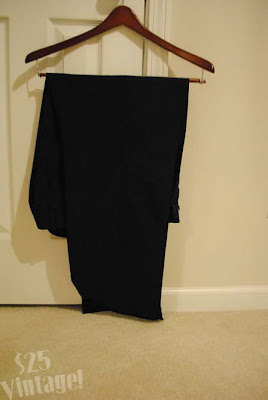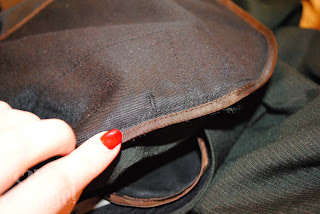Well Fiance is an Attorney and so he spends most of his time in one suit or another. Considering they are his Monday through Friday work wear (and then his Sunday wear too) they get a lot of bumps and scrapes along the way and often need mending for one reason or another. I've had to learn a lot about suit repair in the last two years.
I know a lot of us have special men in our lives and they are often a little rough on their clothing. Though daily suit wear is much less common for the male persuasion than it was even 30 years ago I think more than one of us will have an occasion to mend a pocket or a worn knee at some point. Getting a tailor to do the repairs can get awfully costly.
I always seem to be mending Fiance's clothes so I thought that as I find things to fix I'll share the repairs with you. Most of what I've learned has been from studying clothing, reading old mending pamplets from the 1940s, and guess work. I may not have the best or the prettiest way to repair men's clothing, but I hope you all find these helpful.
Today's Culprit, a pair of suit slacks with two worn pockets.
Today's pocket was the left hand pocket.
This is pretty standard suit pocket wear. It eventually happens to all pockets and arises from general pocket use. The stitching has just popped at the bottom of the pocket there (I'm holding the pants up-side-down) and the side seam has pulled apart. There are no holes in the pocket and the outer fabric has not frayed so this is a pretty easy repair.
It's a little hard to see and I probably should have drawn some arrows on this picture, but the side seam of the pants is the long seam running from the top to the bottom of the picture. To the right of the side seam is the pocket opening and the reinforcement. So, how do we go about fixing this issue?
The easiest thing to do is stitch up the seam from the outside like you would when you're finishing a pillow, but the results are not the nicest looking. It's hard to get the seam flat and it doesn't hold well.
So I recommend that you flip the suit pants inside out and find where the pocket has been attached to the seam allowance of the side seam. This is if you are fixing a front pocket. Back pockets on men's suits tend to be free floating. The brown in this photo is the edging of the pocket. The serged bit attached to it is the side seam.
In my experience there will almost always be a separate row of stitching where the pocket has been sewn down to the seam allowance. Take the time to figure out what row of stitching it is. Trust me, it's a pain if you start ripping the wrong ones. On this suit it was the row of stitching between the top row of stitching (which is from the pocket facing) and the stitches holding on the brown binding,

Get your seam ripper in there and start ripping out just the stitches attaching the pocket to the inside of the suit.

Be careful not to catch any of the serger threads if your suit has them. It can get a little hairy since you're going to have to rip around the pocket stitches, reinforcement stitches, serger stitches, and then of course the seam itself.
Okay so here I've got the pocket pulled away from the side seam and seam allowance. After you've pulled the pocket back you should be able to see where the seam has pulled apart from the inside.
Next bust out your thread and 1940s sewing needle (which are awesomely sharp, but really hurt when you poke yourself with them). I don't like to use beeswax on my thread, but it's certainly an option.
Stitch up the seam making sure to reinforce around the top and the bottom of the opening. I like to use the back stitch for this, but the blanket stitch works pretty well too.
When you've got the seam all sewed up reattach the pocket to the seam allowance.
Make sure to overlap the stitches you didn't rip by about half an inch. It looks best if you use your machine for this, but I didn't really feel like changing my bobbin today so I did it by hand. I used the back stitch again so I could hide the stitches in the machine stitches that were already there. All you have to do here is keep the pocket from moving so you're stitches don't have to be super strong. They just have to be able to keep the pocket in place. Even plain old straight stitch would work here.
New line of stitches on the pants-front side. I hid it in the bottom line of the serger stitches.
And here they are on the pocket side. You shouldn't really notice the repair, although honestly this is the inside of a pair of pants so who really cares right?
And you're done! Pretty simple right? Who needs a tailor? Not my man.



















8 comments:
Nice job! I'll bookmark this in case I ever get asked to mend suit pants. How nice of you to fix up your man's pants for him! :)
Every week when I iron my hubby's clothes, I look for what needs mending. He only wears shirts and slacks for work but does not like shopping for new, so I mend. There is almost always something to do. A series on mending mens clothing would be a real service, no one else is doing it. This is an old skill that is dying. Keep it up.
Anonymous: Thank you, I'm almost sort of hoping for some more complicated repairs to show up. I'd love to show everyone how to reinforce a knee or something.
Thank you for your good work the mens clothes.
cheap designer clothes
Good post. Having a knack for mending your favorite pieces of clothing may be handy in case it's irreplaceable. Thanks for posting.
So nice blog. I appreciate you about persuade to learn something special.
Fleece Sweatpants
I will bookmark this blog so incredible post.
Hanes Sweatshirts
This is my first time visit to your blog and I am very interested in the articles that you serve. Provide enough knowledge for me. Thank you for sharing useful and don't forget, keep sharing useful info: Kilgour Savile Row
Post a Comment